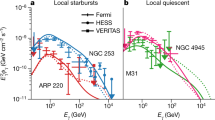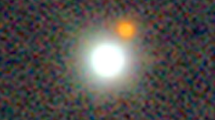Abstract
Bridle and Purton1 have recently presented flux densities at 10.03 MHz for 126 radio sources. The ratio of their observed flux density (Sobs) to that expected (Sexp) from extrapolation of the high-frequency spectrum of each source is correlated with the galactic latitude of the source. For example, the geometric mean value of R = Sobs/Sexp among all sources in their list is 0.99 ± 0.04, but for sources within 15° of the galactic equator it is 0.70 ± 0.10. This attenuation of the 10 MHz flux densities near the galactic equator suggests that free-free absorption in the interstellar medium of the galaxy is significant at 10 MHz. Interstellar absorption of galactic background radiation has been reported at lower frequencies by several authors2–5.
This is a preview of subscription content, access via your institution
Access options
Subscribe to this journal
Receive 51 print issues and online access
$199.00 per year
only $3.90 per issue
Buy this article
- Purchase on Springer Link
- Instant access to full article PDF
Prices may be subject to local taxes which are calculated during checkout
Similar content being viewed by others
References
Bridle, A. H., and Purton, C. R., Astron. J., 73, 717 (1968).
Smith, F. G., Mon. Not. Roy. Astron. Soc., 131, 145 (1965).
Alexander, J. K., and Stone, R. G., Astrophys. J., 142, 1327 (1965).
Ellis, G. R. A., and Hamilton, P. A., Astrophys. J., 143, 227 (1966).
Reber, G., J. Franklin Inst., 285, 1 (1968).
Scheuer, P. A. G., Mon. Not. Roy. Astron. Soc., 120, 231 (1960).
de Jager, G., Lyne, A. G., Pointon, L., and Ponsonby, J. E. B., Nature, 220, 12 (1968).
Gardner, F. F., and Davies, R. D., Austral. J. Phys., 19, 129 (1966).
Pottasch, S. R., Bull. Astron. Inst. Neth., 19, 469 (1968).
Wentzel, D. G., Ann. Rev. Astron. Astrophys., 1, 195 (1963).
Bridle, A. H., Mon. Not. Roy. Astron. Soc., 138, 251 (1968).
Habing, H. J., and Pottasch, S. R., Astrophys. J. Lett., 149, L119 (1967).
Pikel'ner, S. B., Astron. Zh., 44, 915 (1967).
Spitzer, L., and Tomasko, M. G., Astrophys. J., 152, 971 (1968).
Guélin, M., Guibert, J., Huchtmeier, W., and Weliachew, L., Nature, 221, 249 (1969).
Staelin, D. H., and Reifenstein III, E. C., Science, 162, 1481 (1968).
Smith, F. G., Nature, 220, 891 (1968).
Davies, R. D., Booth, R. S., and Wilson, A. J., Nature, 220, 1207 (1968).
Author information
Authors and Affiliations
Rights and permissions
About this article
Cite this article
BRIDLE, A. 10 MHz Absorption in the Local Spiral Arm. Nature 221, 648–649 (1969). https://doi.org/10.1038/221648a0
Received:
Issue Date:
DOI: https://doi.org/10.1038/221648a0
This article is cited by
-
Pulsar dispersion measures and the mean and mean-squared interstellar electron density
Astrophysics and Space Science (1971)
-
Low-frequency Spectrum of the Crab Nebula
Nature (1970)
-
The galactic and metagalactic components of distributed cosmic radio emission
Radiophysics and Quantum Electronics (1970)
-
Distance of Pulsars and the Interstellar Electron Gas
Nature (1969)
-
Distribution and Temperature of Interstellar Electron Gas
Nature (1969)
Comments
By submitting a comment you agree to abide by our Terms and Community Guidelines. If you find something abusive or that does not comply with our terms or guidelines please flag it as inappropriate.



